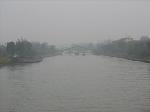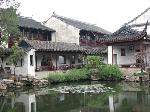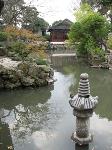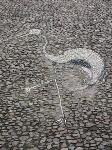- Getting around Lijiang. Dont stay in the Old Towns more than 2 days, there is nothing to do. KRISS Oct 9, 2013 05:46
- 2013 Beijing Temple Fair BENNYLAU Feb 26, 2013 03:29
- Malaysian traveling from KUL - LAX vis Shanghai PVG ZATI_DY Jan 3, 2013 20:15
Where Gardens are the Windows of the Soul
- Views: 7347
- |Vote: 2 0
- |Add to Favorites
- |Recommend to Friends
Bad Weather & History
My long awaited visit to Suzhou happens at long last under a sudden spell of downright miserable weather that casts the day in a grim shroud of cloud, mist and almost incessant rain. I couldn’t have chosen a worse day to start my trip and sitting on the bus, watching the raindrops making streams across the windows, I wonder if I shouldn’t just turn back and give up.
Needless to say I don’t, but the weather casts a grey shadow over the journey, and forces Suzhou to work all the harder to make itself memorable. I’ve found it’s much easier to like a place under blue skies and bright sunshine. To assuage my pessimism, I turn my thoughts to what I know about the history of Suzhou.
Suzhou has a history stretching back some 2500 years and owes its success and renown to the building of the Grand Canal. Finished in the Sui Dynasty (581-618AD), the Grand Canal was to be the major communication route between the north and the south of China, and beyond, for the next few centuries.
Not by coincidence did Suzhou feel the benefits of its proximity to the Grand Canal. Indeed, Suzhou became a storage depot, stopping off point and centre for all shipping activities. As such the city was inundated with the wealthy, from rich shipping merchants to artists, poets and painters.
It must have been some sight, a bustling commercial and artistic city enclosed within a great wall, that itself was surrounded by moats. Water defined the city in numerous canals that bisected it, and seems to have contributed hugely to the romantic notions the city inspired. Not only this, but in around the 14th century, Suzhou had become a centre for silk production in China. This attracted a whole new set of clientele and hangers-on, from the aristocracy downwards, and the rich and famous from all parts of society began to hanker after dwellings there.
This intermingling of wealth and art is what has lead to Suzhou’s current status as a tourist attraction in the 21st century. Although much of its original beauty has been lost, damaged or destroyed, it’s possible to see it in the few canals that still straddle the city and more importantly, in the walled worlds of its gardens. During the Ming Dynasty (1368-1644), the gardens in Suzhou numbered over 200: this was their boom-time. Fortunately for us, some of the gardens still remain, if greatly reduced in number, to provide a pause in the urban expansion of the city and to offer a glimpse into Suzhou’s ancient soul.
[image: suzhou canal in the rain]
The Master of Nets Garden
The Master of Nets Garden is the smallest garden in Suzhou (0.54 hectares) and was recognised as a perfectly formed example, in their words a “masterpiece” of Chinese Garden Design by the World Heritage in 1997. Before this is was planned but abandoned in the 12th century, purchased by a retired official renamed and renovated in the Qing Dynasty and eventually restored to its modern day form in 1982.
The first thing I notice about the garden is that it feels much bigger than it is. Smuggled in between the residential buildings, it really does only occupy a small space, but such is the cleverness of the design that every device has been used to defy smallness.
You don’t need to be an expert to appreciate the ideas. It might seem like madness to place a large pool in a confined space, but the centre of this garden is just that. Much as a mirror, strategically placed in a small room can make it feel much larger, so water can perform exactly the same trick. It reflects the buildings, the berries hanging on the trees and the sky giving the garden an infinite quality, as though it were stretching to the clouds.
Aesthetically it’s beautiful: whether the water-lilies are in bloom during spring and summer, or whether you’re here in autumn, as I am, watching the peaceful procession of fish under the surface. Naturally, an open sided pavilion, named the “Waterside Pavilion” sits on the far side of the pool offering a resting place to enjoy it. The windows of the pavilion are carved with images from “Three Kingdoms” one of the four greatest classical novels of Chinese literature.
This brings in the influence of the arts in Chinese Garden Design. For the Chinese tradition is very much a fusion of arts, the designs sympathetic to poetry and literature, art and sculpture. This garden is a typical example of the effect of artistic notions of proportions, balance and harmony to impress beauty and peace into a place.
Such attention to beauty and detail can be seen in the carvings on windows, wood and stone balustrades, as though they are works of art. It can also be seen in the wonderfully patterned floors, one of my favourite aspects of this garden. Set into the walkways are mosaics of plants, a deer and an elegant crane, one foot raised in silent dance. The mosaics are created using pebbles and tiles.
Plants also have a role in the Chinese garden, as focal points, bringers of sound, colour, shape and texture. My Autumn visit sees the upright red berries of nandinas, the fiery fingers of acers and the true, untarnished greens of bamboos. Evergreen shrubs such as camellias add their strong shiny-leaved foliage and long-needled branches of pines seem fairylike, stretching out over the pool. Chinese bonsai trees in pots dot the garden and cloud-pruned shrubs bring in circular forms. A carpet of ground-hugging greenery underneath a selection of deciduous trees whose bare trunks seem to have been especially designed to add shape, is another of my favourite spots.
The garden abounds with round windows and zigzagging paths that heighten the sense of movement and space; and a November visit means I can appreciate the essence of this without the noise and busyness of summer crowds. The windows provide glimpses into other areas in the garden that always pull me onwards as though I am an explorer in an unknown land. Even when I’ve already traversed the garden, the layout is such that I see the same parts I’ve trodden from new angles and it seems as though I haven’t been here before.
[image: central pool in the garden]
The Humble Administrator’s Garden
A World Heritage site since 1997, the Humble Administrator’s Garden was conceived in 1509 by a retired Imperial Inspector who took as his inspiration an essay written in the Jin Dynasty (265-420) called: “Staying at Home, Idle”. The essay is said to have contained this line: “To cultivate my garden and sell my vegetable crop... is the policy of a humble man”, although the pure beginnings of the garden were tarnished when its owners son gambled it away.
At over 5 hectares in area, the garden is 10 times larger than the Master of Nets Garden, and with such a grand space there is a danger of losing the sense of intimacy that a garden creates. I wonder if large areas will be given over to woodland, or lawn, as is the English tradition, but this is not the case. Although it does feel more like a park than a garden in places, the Humble Administrator’s Garden is more like a serious of connecting gardens, each with its own sense of proportion and balance: a Master of the Nets on a massive scale.
The garden is broadly divided into three separate parts known as the eastern, middle and western parts. The eastern part is perhaps the most informal of the three areas, displaying one of the fundamental concepts of Chinese Design that is to create a microcosm of the outer landscape. As I walk this section of the garden I feel very much that I am in a miniature of the natural wilderness: rock gardens that represent mountains, filled with pines and bamboos; islands encircled with streams that represent hills and rivers; and great towering trees particularly the buttery yellow gingkoes and the blood red acers that feel like an autumnal woodland.
The middle part of the garden is quite different, focussing on the structure of pavilions, bridges and halls, clustered around a lake. I can sense the change from the apparently natural to the more structured middle section. The inclusion of so many buildings might have cramped a lesser space, but here they are artfully placed, so that from one pavilion you can see views of another in the distance. Large trees and bamboos soften the hard edges and the water reflects the colours, textures and architectures of the buildings.
The western part of the garden borrows the edge of the lake for its Keep and Listen Pavilion which is designed to look like a boat moving away from a pier. Small pools and linking rocky waterways are home to pairs of Mandarin ducks. Covered walkways and corridors edge the waters to allow the appreciation of the garden in any weather and I can imagine sitting and watching the dancing of raindrops on the surface of the streams to be as beautiful as admiring the perfect blue sky they must mirror on a fine day. A large bonsai garden also resides in this section with over 700 specimens.
[image: pool & pavilion in the garden]
The Windows of the Soul
Suzhou has always been an attractor of epithets, be it “Venice of the Orient”, “Garden City” or as the lesser-half of the Chinese saying: “In the skies there is Heaven, on the Earth there are Suzhou and Hangzhou”.
When describing people, we say that “the eyes are the windows of the soul” and if that is so then perhaps I can say, about this place, that “Gardens are the windows of the soul”. Suzhou’s prosperous history may indeed have begun with canals, but its soul is a mixture of artisans and poetry, water and wonder and nowhere is this better represented than in the gardens that remain.
They are not just microcosms of a natural landscape, but microcosms of a way of living and being, a glimpse into the minds and manifestations of Chinese culture, history and life. What remains today in the placement of rock and stone, in the stories of the gardens, in the wealthy designs and humble intentions, is an outpouring of heart and mind, a fragment of Suzhou’s soul.
[image: a window, humble administrator's garden]
Travel Information (November 2007)
Please note that this information is from travelling in the off-peak season, during November, and therefore ticket prices may be more expensive in the spring and summer months.
Getting There:
From: Hangzhou East Bus Station (杭州东站)
To: Suzhou South Bus Station (苏州南站)
Cost: 65RMB
Ticket prices:
The Master of the Nets Garden (网师园)
20RMB
The Humble Administrator’s Garden (拙政园)
50RMB
More Information:
More information about the specific gardens selected, their size and locations and also 3-d panoramic tours can be found by following this link to the Unesco site Suzhou page.
Gardens currently protected: http://whc.unesco.org/en/list/813/
[image: crane, master of nets garden]








 Copyright © 1998-2025 All rights reserved.
Copyright © 1998-2025 All rights reserved.
1.
Sep 21, 2008 11:09 Reply
SNOWHOG said:
Lemoncactus, my wife and I also visited Suzhou in the fall of 2007. Your knowledge of traditional Chinese garden design clearly helped you appreciate the gardens of Suzhou. They are indeed oases of beauty in what otherwise seems to be an unexceptional Chinese city - lots of traffic and factories. For centuries the Yangtze delta region was celebrated for its beauty in paintings and poetry. Fortunately there are many beautiful places such as the nearby canal town of Tongli still left. Industrialization, however, has blighted much of the area. We went to see Taihu Lake and were disappointed by the fact that the smog limits visibility to perhaps one kilometre. If only we could visit the Suzhou of 1,000 years ago!